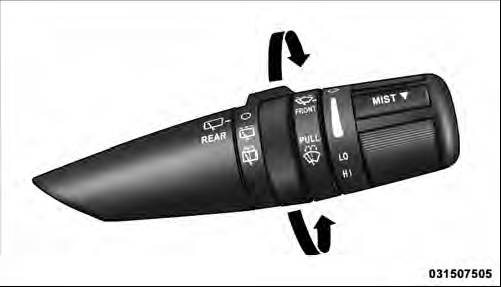Jeep Liberty: Rear Window Features
Rear Window Wiper/Washer
The rear wiper/washer is controlled by a rotary switch located on the control lever. The control lever is located on the right side of the steering column.

Rear Wiper/Washer Control

Rotate the switch upward to the first detent position for rear wiper operation.
NOTE: The rear wiper operates in an intermittent mode only.

Rotate the switch upward past the first detent to activate the rear washer. The washer pump will continue to operate as long as the switch is held (for a maximum of 10 seconds). Upon release, the wiper will cycle two times before returning to the set position.
If the rear wiper is operating when the ignition is turned OFF, the wiper will automatically return to the “park” position. When the vehicle is restarted, the wiper will resume function at whichever position the switch is set.
NOTE: The rear wiper and the rear washer will not operate If the liftgate flipper glass is open.
Rear Window Defroster

The rear window defroster button is located on the climate control (Mode) knob. Press this button to turn on the rear window defroster and the heated outside mirrors. An indicator in the button will illuminate when the rear window defroster is on. The rear window defroster automatically turns off after approximately 10 minutes. For an additional five minutes of operation, press the button a second time.
NOTE: To prevent excessive battery drain, use the rear window defroster only when the engine is operating.
CAUTION!
Failure to follow these cautions can cause damage to
the heating elements:
• Use care when washing the inside of the rear window. Do not use abrasive window cleaners on the interior surface of the window. Use a soft cloth and a mild washing solution, wiping parallel to the heating elements. Labels can be peeled off after soaking with warm water.
• Do not use scrapers, sharp instruments, or abrasive window cleaners on the interior surface of the window.
• Keep all objects a safe distance from the window.
Roof Luggage Rack — If Equipped
NOTE: Roof rack and crossbars cannot be used on vehicles equipped with Skyslider .
The load carried on the roof, when equipped with a luggage rack, must not exceed 150 lbs (68 kg), and it should be uniformly distributed over the cargo area.
Crossbars should always be used whenever cargo is placed on the roof rack. Check the straps frequently to be sure that the load remains securely attached.
NOTE: Crossbars are offered by MOPAR accessories.
External racks do not increase the total load carrying capacity of the vehicle. Be sure that the total occupant and luggage load inside the vehicle, plus the load on the luggage rack, do not exceed the maximum vehicle load capacity.
CAUTION!
• To avoid damage to the roof rack and vehicle, do
not exceed the maximum roof rack load capacity.
Always distribute heavy loads as evenly as possible and secure the load appropriately.
• Long loads, which extend over the windshield, such as wood panels or surfboards, should be secured to both the front and rear of the vehicle.
• Place a blanket or other protection between the surface of the roof and the load.
• Travel at reduced speeds and turn corners carefully when carrying large or heavy loads on the roof rack. Wind forces, due to natural causes or nearby truck traffic, can add sudden upward loads.
This is especially true on large flat loads and may result in damage to the cargo or your vehicle.
WARNING!
Cargo must be securely tied down before driving
your vehicle. Improperly secured loads can fly off the
vehicle, particularly at high speeds, resulting in personal
injury or property damage. Follow the roof rack
cautions when carrying cargo on your roof rack.
See also:
Capacities and recommended fuel/lubricants
1: For additional information, see “Engine oil” in the “8. Maintenance and
do-it-yourself” section for changing engine oil.
2: For additional information, see “Engine oil and oil filter recommendation”
later in this section.
3: Us ...
Lift gate
- Always be sure the lift gate has
been closed securely to prevent it
from opening while driving.
- Do not drive with the lift gate open.
This could allow dangerous exhaust
gases to be drawn into the vehicle.
See “Exhaust gas (carbon m ...

 Cargo Area Features
Cargo Area Features